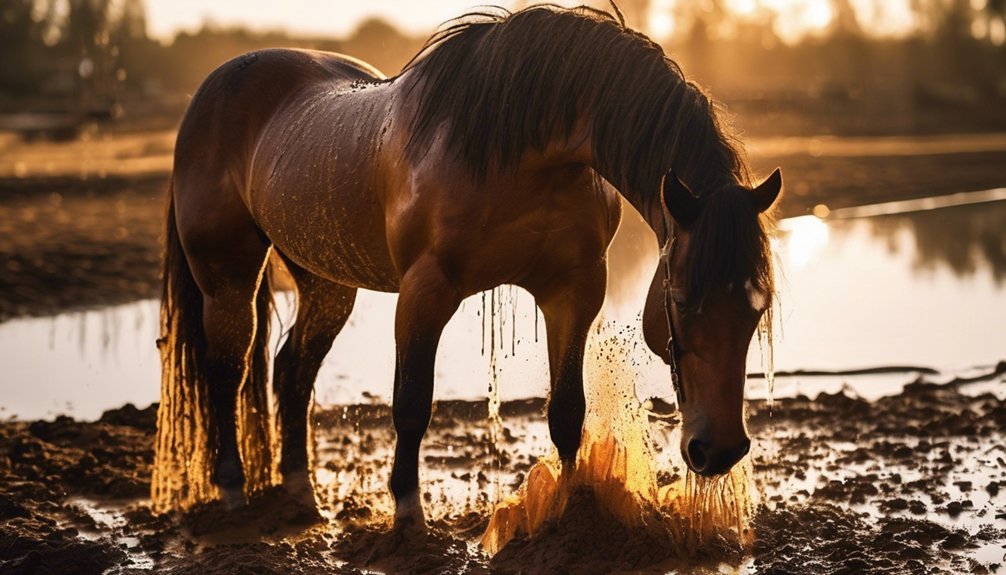
Grooming horses in muddy conditions can be a challenge, but it's essential for their health. First, you'll need to assess your horse's condition for any injuries. Once you've done that, gather the right tools to tackle the mud effectively. Understanding the proper techniques for removing caked mud will make a significant difference. Plus, don't overlook hoof care and skin maintenance in these damp environments. Let's explore the best methods to keep your horse comfortable and clean.
Key Takeaways
- Regularly assess your horse for soreness, cuts, or abrasions, especially on sensitive areas like the belly and legs.
- Use a rubber curry comb in circular motions to loosen caked-on mud, followed by a stiff-bristled brush to sweep it away.
- Clean hooves daily to remove mud and debris, checking for signs of thrush or rot.
- Apply skin moisturizers to prevent dryness and chafing, particularly after muddy conditions.
- Finish grooming with a soft brush for sensitive areas and a damp cloth for stubborn spots on the face.
Assessing the Damage: Evaluating Your Horse's Condition

Before you begin grooming your horse, it's crucial to assess its condition to identify any areas needing special attention.
Start by examining your horse's muddy coat; look for clumps of dirt that may hide skin sensitivity or irritations. Gently run your hands along its body, checking for any signs of soreness, cuts, or abrasions.
Pay close attention to sensitive areas like the belly and legs, where mud can cause irritation. If your horse shows signs of discomfort, note those spots for extra care later.
Don't forget to assess the hooves, as mud can pack in, leading to infections.
Essential Grooming Tools for Muddy Environments
Effective grooming in muddy environments requires the right tools to tackle the unique challenges posed by dirt and debris.
You'll want to invest in a few essential items that make the process smoother and more effective.
- Mud Brushes: These stiff-bristled brushes excel at removing caked-on mud, helping to restore your horse's coat without causing irritation.
- Shedding Blades: Perfect for removing loose hair and dirt, these blades can also help distribute natural oils, promoting a healthy shine.
- Rubber Curry Comb: This versatile tool helps loosen dirt and debris while providing a gentle massage, making it a favorite among horses.
With these tools in hand, you'll be well-equipped to tackle mud and keep your horse looking and feeling their best.
Step-by-Step Mud Removal Techniques

With the right grooming tools at your disposal, you can tackle mud removal efficiently and keep your horse comfortable. Start by using a rubber curry comb to loosen the mud from your horse's coat. Work in circular motions, focusing on areas where mud clumps are stubborn.
Next, grab a stiff-bristled brush to sweep away the dislodged mud. For finer details, switch to a soft brush for sensitive areas, ensuring you're gentle. Don't forget to wipe down your horse's face with a damp cloth to remove any stubborn spots.
Finally, a finishing touch with a mane comb can help detangle any debris. These grooming techniques not only clean but also strengthen your bond with your horse, making the process enjoyable for both of you.
Caring for Your Horse's Hooves in Wet Conditions
Although wet conditions can be challenging for your horse's hooves, taking proactive measures can help maintain their health and integrity.
Regular hoof hygiene is crucial during these muddy times. Start by cleaning your horse's hooves daily to remove mud and debris. Keep an eye out for signs of thrush or rot, which can thrive in wet environments.
Consider these moisture management tips:
- Use hoof oil: Applying a protective hoof oil can help seal moisture out.
- Pick out hooves: Daily picking keeps the hooves dry and clean.
- Provide dry footing: Whenever possible, ensure your horse has access to dry ground.
Maintaining Skin Health and Preventing Irritations

To keep your horse's skin healthy and prevent irritations, it's essential to establish a regular grooming routine. Start by brushing away mud and debris gently, focusing on sensitive areas like the belly and legs.
After grooming, apply skin moisturizers to areas prone to dryness and chafing, especially in muddy conditions. These products help maintain hydration and can create a barrier against irritants.
Keep an eye out for signs of irritation, such as redness or excessive itching. If you notice any issues, consult your vet promptly for tailored advice.
Frequently Asked Questions
How Often Should I Groom My Horse in Muddy Conditions?
You should groom your horse daily in muddy conditions. This regular grooming frequency helps manage mud, keeping your horse comfortable and healthy. Don't forget to check for skin irritations or injuries during each session!
Can Muddy Conditions Lead to Skin Infections in Horses?
Muddy conditions can certainly test your horse's resilience, leading to skin infections if left unchecked. You'll want to monitor mud exposure effects closely and prioritize skin care to keep your equine friend healthy and happy.
What First Aid Supplies Should I Keep for Muddy Conditions?
You should always have first aid supplies like antiseptic wipes, bandages, and ointments on hand. These essential supplies help you quickly address any skin irritations or injuries, ensuring your horse stays healthy and comfortable in challenging conditions.
How Do I Prevent My Horse From Rolling in Mud?
You can't let your horse turn into a mud monster! Use mud deterrents like sprays or blankets, and create a rolling prevention routine. Regular exercise and keeping them occupied will also help keep them clean and happy.
Are There Specific Shampoos for Horses That Have Been in Mud?
When dealing with muddy horses, you'll find several mud shampoo options designed for equine coat care. Look for shampoos that effectively break down dirt and oils, ensuring your horse's coat stays clean and healthy.
Conclusion
Grooming your horse in muddy conditions might seem daunting, but it's essential for their well-being. You may worry that it takes too much time, but with the right tools and techniques, you can make it efficient and effective. By regularly assessing your horse's condition and using a systematic approach to mud removal and hoof care, you ensure they stay healthy and comfortable. Remember, a clean horse is a happy horse, even in the messiest of environments.





